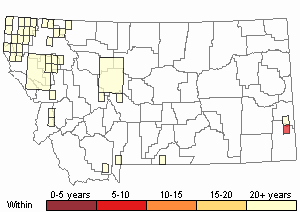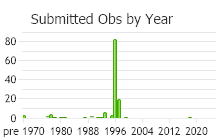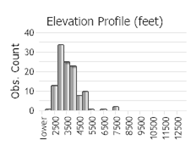View in other NatureServe Network Field Guides
NatureServe
Montana
Utah
Wyoming
Idaho
Wisconsin
British Columbia
South Carolina
Yukon
California
New York
Shaggy Mat Moss - Brachythecium salebrosum
General Description
Plants: Pleurocarpous (Vitt 1988). Growing in somewhat crowded mats, in shades of yellow to brown (FNA 2014), often shiny (Lawton 1971). Stems prostrate, to 8 cm in length, pinnate or erratically so; possessing a central strand. Branches straight or a little bowed, to 8 mm in length (FNA 2014).
Leaves: Stem leaves upright or spreading a little, overlapping slightly or a little more distantly spaced, 1.7-2.6 mm in length, 0.6-1 mm in width, lance-shaped, sometimes with ovate tendencies, narrowing to form a long acumen, somewhat cupped, pleated longitudinally, slightly curved (falcate), sometimes secund; margins finely saw-toothed (FNA 2014) to smooth, sometimes flat or curved back and down proximally (Lawton 1971); base slenderly extending down the stem slightly (FNA 2014) or not (Crum & Anderson et al. 1981); costa robust, extending to ca ¾ or a little less of the leaf length, with a dorsal spine above. Branch leaves smaller and more slender than the stem leaves (FNA 2014).
Leaf Cells: Stem leaves with alar cells nearly square or slightly lengthened, the walls somewhat thick, the alar area well-demarcated and small; basal cells similar in size or larger than the alar cells (FNA 2014), typically porose (Lawton 1971), in 1 or 2 series, not distinctly dissimilar to the laminal cells adjacent to and above them; laminal cells long and narrow (FNA 2014). Branch leaf cells with basal laminal cells swollen along the leaf bottom (FNA 2014).
Diagnostic Characteristics
The notable combination of features includes the pleated, curved and lance-shaped leaves with the fine saw-toothed edges, and the slender laminal cells extending nearly to the bottom margin of the leaf adjacent to the costa (FNA 2014).
Brachythecium acutum also has leaves that narrow gradually but are seldom falcate (or secund). Although infertile plants of B. campestre that are robust can be distinguished from B. salebrosum by characteristics of the supra-alar cell region, smaller infertile plants probably cannot (FNA 2014).
Range Comments
North American Range
Canada: YT, ON to NL and NB; USA: CA, UT, CO and NM (FNA 2014). Known in Montana from Big Horn, Blaine, Carbon, Cascade, Fallon, Flathead, Gallatin, Glacier, Lake, Lewis and Clark, Lincoln, Madison, Meagher, and Missoula Counties (Elliott 2016).
Observations in Montana Natural Heritage Program Database
Number of Observations: 152
(Click on the following maps and charts to see full sized version)
Map Help and Descriptions
Relative Density

Recency



 (Observations spanning multiple months or years are excluded from time charts)
(Observations spanning multiple months or years are excluded from time charts)
Habitat
Open to shaded sites on stones, soil, also on decaying wood, tree bottoms (FNA 2014), and humus in coniferous forests (Elliott 2016), disturbed areas such as exposed hillocks in forests of hardwood or lawns (Crum & Anderson et al. 1981). Elevation: 3-4920 feet (FNA 2014).
Reproductive Characteristics
Autoicous. Perichaetial leaves enveloping the stem somewhat, the apices spreading (Lawton 1971). Seta smooth, 1-2 cm tall, deep brown or brown with some orange tones (FNA 2014) to yellow (Crum & Anderson et al. 1981). Capsule 2 mm in length, deep brown, a little bowed and slightly stretched-looking (FNA 2014), level, the theca 1.8-2.4 mm in length; operculum tall and cone-shaped, ca 0.7 mm; cilia knobby, sometimes transversely ridged (Lawton 1971).
References
- Literature Cited AboveLegend:
 View Online Publication
View Online Publication Crum, H.A. and L.E. Anderson. 1981. Mosses of Eastern North America. 2 volumes. Columbia University Press, New York. 1328 pp.
Crum, H.A. and L.E. Anderson. 1981. Mosses of Eastern North America. 2 volumes. Columbia University Press, New York. 1328 pp. Elliott, J.C. and A.K. Pipp. 2018. A Checklist of Montana Mosses (1880-2018). Updated 3 January, 2020. Montana Natural Heritage Program, Helena, Montana. 73 pp.
Elliott, J.C. and A.K. Pipp. 2018. A Checklist of Montana Mosses (1880-2018). Updated 3 January, 2020. Montana Natural Heritage Program, Helena, Montana. 73 pp. Flora of North America Editorial Committee, eds. 2014. Flora of North America North of Mexico. Volume 28. Bryophytes: Mosses, Part 2. Oxford University Press, Inc., NY. xxi + 702 pp.
Flora of North America Editorial Committee, eds. 2014. Flora of North America North of Mexico. Volume 28. Bryophytes: Mosses, Part 2. Oxford University Press, Inc., NY. xxi + 702 pp. Lawton, E. 1971. Moss Flora of the Pacific Northwest. Hattori Botanical Laboratory. Japan: Yamabuki-cho, Shinjuku-ku, Tokyo. 362 pages plus appendices.
Lawton, E. 1971. Moss Flora of the Pacific Northwest. Hattori Botanical Laboratory. Japan: Yamabuki-cho, Shinjuku-ku, Tokyo. 362 pages plus appendices. Vitt, D. J. Marsh, and R. Bovey. 1988. Mosses, Lichens & Ferns of Northwest North America. Seattle, WA: University of Washington Press. 296 p.
Vitt, D. J. Marsh, and R. Bovey. 1988. Mosses, Lichens & Ferns of Northwest North America. Seattle, WA: University of Washington Press. 296 p.
- Additional ReferencesLegend:
 View Online Publication
View Online Publication
Do you know of a citation we're missing? Elliot, J. C. 1993. Second checklist of Montana mosses. Unpublished report. U.S. Forest Service, Region 1. Missoula, MT. 45 pp.
Elliot, J. C. 1993. Second checklist of Montana mosses. Unpublished report. U.S. Forest Service, Region 1. Missoula, MT. 45 pp. Flowers, S. 1973. Mosses: Utah and the West. Brigham Young University, Provo, Utah. 567 p.
Flowers, S. 1973. Mosses: Utah and the West. Brigham Young University, Provo, Utah. 567 p. Lawton, E. 1971. Keys for the Identification of the Mosses on the Pacific Northwest. Reprinted from 'Moss Flora of the Pacific Northwest'. Published as Supplement No. 2 of the Journal of the Hattori Botanical Laboratory. Nichinan, Miyazaki, Japan. 66 pp.
Lawton, E. 1971. Keys for the Identification of the Mosses on the Pacific Northwest. Reprinted from 'Moss Flora of the Pacific Northwest'. Published as Supplement No. 2 of the Journal of the Hattori Botanical Laboratory. Nichinan, Miyazaki, Japan. 66 pp. Malcolm, B., N. Malcolm, J. Shevock, and D. Norris. 2009. California Mosses. Nelson, New Zealand: Micro-Optics Press. 430 pp.
Malcolm, B., N. Malcolm, J. Shevock, and D. Norris. 2009. California Mosses. Nelson, New Zealand: Micro-Optics Press. 430 pp. Smith, A.J.E. 1980. The Moss Flora of Britain and Ireland. Cambridge University Press, Cambridge. 705 pp.
Smith, A.J.E. 1980. The Moss Flora of Britain and Ireland. Cambridge University Press, Cambridge. 705 pp.
- Web Search Engines for Articles on "Shaggy Mat Moss"





